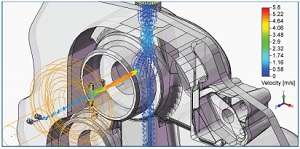Latest News
May 31, 2012
By Anthony J. Lockwood
Read: What They Didn’t Teach You in Engineering School About 3D Pressure Drop Analysist |
Dear Desktop Engineering Reader:
Debate over the benefits of early and often computational fluid dynamics (CFD) is pretty much done with. It’s a given that CAD mavens can handle many routine analyses, saving time and freeing the CFD specialists— in-house or out$ourced (sic)—to do the gnarly jobs. The CFO’s elation over the elimination of countless costly physical prototypes is unbounded. Still, is upfront CFD analyses as efficient as technology allows it to be? Could there be a better way? Such are the questions underlying today’s Check It Out white paper about FloEFD design/analysis technology from Mentor Graphics.
As you no doubt surmise, “What They Didn’t Teach You in Engineering School About 3D Pressure Drop Analysis” answers “yes, there’s a better way.” Mentor Graphics calls it “Concurrent CFD,” and this paper demonstrates how the technology in FloEFD offers a more efficient process than either traditional or upfront CFD for solving advanced pressure drop problems. This is a good read.
In a nutshell, FloEFD CFD combines the phases of pressure drop analysis in one application—solid modeling, problem set-up, visualization, validation, reporting, and so forth. What’s key is that FloEFD is CAD-embedded as opposed to CAD-enabled, so it inherently understands the geometry. Further, as a designer you run FloEFD analyses from inside the CAD environment, so you stay within your, say, CATIA, Creo, or NX comfort zone. This also means that changes discovered in analysis are made directly in CAD model, keeping it and the analysis in synch.
For drop pressure analyses, this means FloEFD rejiggers your simulation process. For example, it eliminates a number of separate steps that can introduce noise and human error in both traditional and upfront CFD processes, including geometry transfers to and from the CFD application and creating a cavity to represent the flow space. Rather, FloEFD already has the geometry and it recognizes the CAD geometry for both internal and external flows. So, after cleaning, you proceed directly to applying boundary conditions then meshing. The efficiencies wrought by Concurrent CFD, says Mentor Graphics, can reduce simulation time by from 65 to 75% in comparison to traditional and upfront CFD processes.
The first seven pages of this 12-page white paper look various pressure drop problems, including total pressure and valve designs with small flow passages. The final section offers brief case studies of applied FloEFD from a number of industries. All of the document is richly illustrated, in depth yet easy to read. Very well done.
As Martha Stewart might say, it’s a good thing that CFD analysis has moved upfront in the design process. Mentor Graphics, however, might just take that a bit further and say that Concurrent CFD as part of the design process is an even a better thing. This white paper makes a strong case backing up that assertion. Hit the link over there, get it, and decide for yourself.
Thanks, Pal. — Lockwood
Anthony J. Lockwood
Editor at Large, Desktop Engineering
Subscribe to our FREE magazine, FREE email newsletters or both!
Latest News
About the Author
Anthony J. Lockwood is Digital Engineering’s founding editor. He is now retired. Contact him via [email protected].
Follow DE






